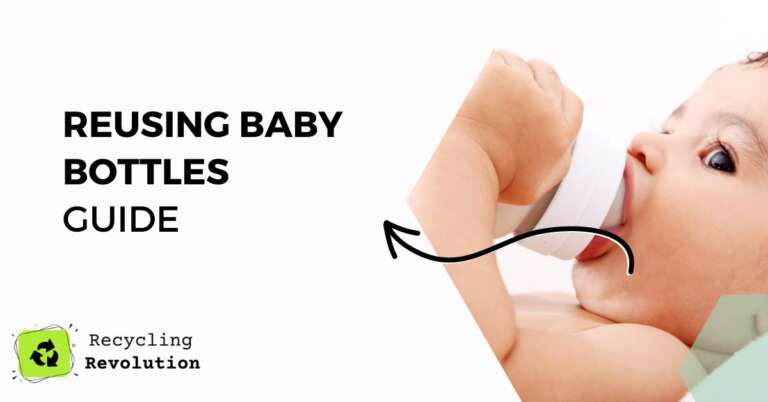Baby bottles are one of the necessities mothers purchase for feeding their babies and time after time used bottles can be tempting to use, whether a friend or a deal pops up on Goodwill or Facebook marketplace to buy a whole set of baby bottles for cheap. But when it concerns their child’s welfare it’s best to approach with caution.
Your baby is new to the world which means they are probably not used to other people’s germs which is the main cause of any concern.
If you’re wondering if its okay to use old/used baby bottles then we will discuss everything you need to know and guide you on the safest option for your baby.
Great Alternative Uses for Old Baby Bottles
Sometimes, while baby bottles are designed primarily for feeding babies, there are some alternative uses for them. Here are a few ideas:
- Measuring liquids: Baby bottles are designed with clear volume markings, making them useful for measuring liquids. You can use them to measure and mix ingredients for recipes, such as salad dressings or pancake batter.
- Storing and organizing small items: The small size of baby bottles makes them ideal for storing and organizing small items, such as jewelry, buttons, or craft supplies. You can even attach a label to the bottle to easily identify its contents.
- Dispensing liquids: Baby bottles can be used as a simple dispenser for liquids, such as soap or shampoo. Simply fill the bottle with the liquid, add a dispenser top, and use as needed.
- Creating sensory bottles: Sensory bottles are a popular DIY project for children. To create one, fill a baby bottle with items like glitter, beads, or small toys, and then add water or oil. The bottle can be shaken and turned to create a visually stimulating sensory experience.
- Drinking water: If you are out and about and don’t have a water bottle handy, a baby bottle can be a useful alternative. Simply fill it with water and drink from the nipple.
While baby bottles may not have been designed for these alternative uses, they can be repurposed in creative ways. However, it’s important to ensure that any alternative use of a baby bottle is safe and clean to avoid potential health risks.
Best Ways To Reuse a Baby Bottle Safely
Choosing baby bottles might be challenging because there are various varieties. Here are some fundamentals about infant bottles to assist you:
1. Do not stock up on one type of bottle. You never know whether your baby may reject it! Start with the small ones and perhaps test out two distinct types.
2. We all know that bottles are made out of glass, stainless steel, silicone, or plastic. Each one has upsides and downsides and varies in cost and longevity. Thus, choose BPA-free bottles.
3. Pick the bottles your baby will accept. For example, most bottles are tall and straight, angled (curved at the neck), and have broad forms to hold wide, short nipples looking like a breast.
4. Small (4 oz) and big bottles are available (8 oz). While infants may find small sizes pleasant, babies usually outgrow them. So, keep in mind to check on bottle tests and change them if they begin to weaken or if they start to become slippery, yellow, broken, or ripped.
Here’s what to check before reusing
There are a few indicators, including:
- Surface nicks or debris on the bottle or treat.
- Plastic that is split or cracked.
- Plastic discolouration or yellowing.
- Plastic with a fragile or brittle feeling.
- Nipple deterioration or damage, such as fractures or cracks.
If you see or observe these signs of damage, buy new baby bottles to ensure they are clean and safe. Baby bottles and other feeding gear can get old or broken over time, changing how they look and work.
Hence, choose modern and well-maintained nursing hardware to confirm your child is getting the best and healthiest feedings possible.
How To Clean And Sterilize Baby Bottles For Reuse
Health is wealth, and every newborn deserves full attention and care. Since you can reuse their bottles, you should clean and sterilize them after each use to prevent the spread of bacteria. Below is how to do it:
- Wash the bottles in hot, soapy water to remove leftover milk or food from the interior of the bottles.
- After that, swirl the water around and rinse the bottle with clean water. Repeat this step until the bottle is clean and safe.
- Then, sterilize the bottles by putting them in hot water. You can also use an electric sterilizer. Read the instructions for the sterilizer you have. Make sure there is enough water in the bottle to cover it completely. Wait for five minutes, then remove them from the pot.
- Lastly, set them on a clean dish rack to air dry. After drying the bottles, keep them in a clean baby cabinet to stay protected from bacteria and dust.
Are there any risks associated with reusing baby bottles?
You want to get your money’s worth because feeding bottles might be pricey. Before making your choice, you should be aware of the risks when using old baby bottles.
One of the risks of reusing baby bottles is that they can harbor bacteria. There is no guarantee of no bacteria, even after a thorough cleaning. It can be dangerous for your child because they can develop illnesses if they consume bacteria-laden milk.
Another risk is that they can leach chemicals into the milk. For instance, if the bottles are made of plastic, these chemicals are detrimental to your baby’s health. So, it is best to use new bottles.
NOTE: Check your baby bottle for scratches or breaks before you reuse it. If there are any, reusing is probably not safe. Purchase a new bottle and toss the old one away.
Look at the bottom to check if your baby bottle has a recycle sign with the number 7 in the middle. If so, it probably contains BPA, and you should not use it again.
Finally, give the bottle a sniff – if it smells weird, it is not safe to use. Go to the baby wares section and pick a new one.
Conclusion
In conclusion, it is safe to reuse baby bottles as long as they are well-cleaned and sanitized. After each usage, wash them with hot, soapy water, and sterilize them regularly. If you notice any cracks or damage, replace the bottle.
Frequently Asked Questions
Do baby bottles and their nipples expire?
New baby bottles last for three years, but after use, they only last for around six months. Furthermore, the more you use the bottles, the faster they may deteriorate due to heat from regular cleaning or other factors like fractures and scratches.
How many times can I reuse my baby bottle?
If your baby bottle is still good, you can use it 2-3 times, but you cannot reuse the teats because they do not last and can split or break over time (even if they appear good), which can be dangerous.
How frequently should I change infant bottles?
Replacement of bottles is advisable every 4-6 months. Even if they show no sign, change them to avoid contamination. Your baby’s health should always be your priority.

